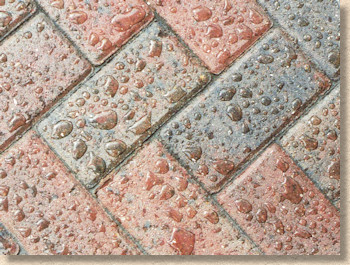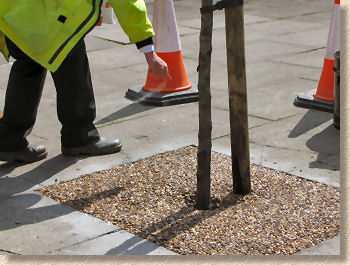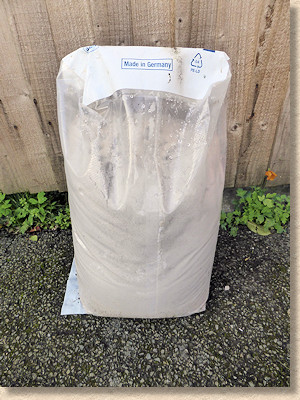
We have a recently laid patio with natural sandstone, sawn and honed. The contractor has applied a sealant in accordance with the paving supplier recommendations. It is dangerously slippery when wet. Is there a remedy?
Why it happens:
Often, when a sealant is new, the surface is incredibly super-smooth, like a newly high-gloss painted door, and water can be observed to bead on the surface, gather in small droplets that just sit there until they evaporate, and these droplets can often turn what should be a relatively safe surface into a potential hazard simply by acting as a type of lubricant between the soles of shoes or boots and the newly-sealed surface below.
It doesn't last forever:
The good news is that, in the vast majority of cases, the slipperiness literally wears off with time, ande, usually within a few months, the surface develops much more traction.
Bit by bit, dust, dirt and detritus from the atmosphere and the general environment will settle onto the the newly-sealed surface, and will gradually roughen it, removing much of that surface sheen. The incidence of water beading will reduce or even disappear completely, and the surface will be much, much safer.

However, for those first few weeks or months, there *is* a simple method to accelerate this surface roughening and render the sealant less of a risk.
The simple fix:
Where a potentially slippery sealant will be used, a traction aid (usually a polymer/polyethylene grit or aluminium oxide grit as used with some sandpapers) should be mixed into the liquid sealant prior to its application.
An alternative strategy suitable for use with some products is for the grit to be scattered onto the surface while the sealant is fresh, so that it binds to the surface.
Both strategies will immediately provide extra grip from the moment the pavement is first used.


However, with pavements that have already been sealed, all is not lost. If you get a bag of kiln dried jointing sand from your local BM or DIY shed, and scatter a light peppering of that over the pavement, it will 'scratch' the surface of the sealant, roughening it up and thereby generating more traction.
This effect is barely noticeable to the eye and is, essentially, a simple acceleration of what will happen naturally over the first 3-6 months of the sealant's life. When you come to have the sealant re-done (if you choose to do so at the end of its service life in 2-3 years) then ensure that a traction aid, such as Rhino-Grip, is sprinkled over the surface at the time, then you shouldn't need to rely on kiln-dried sand.
Suggestions:
The following are NOT recommendations. Pavingexpert has not tested any of these products but has compiled the list of anti-slip additives based on feedback from trusted contractors and other site-users.
You should check the suitability of any product with the manufacturer prior to purchasing.
